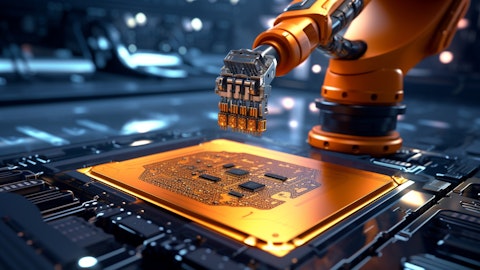Jeff Su: Okay. Thank you, Laura. So Laura’s first question is on AI, but more specifically edge or what we call on-device AI. She notes that there’s AI being added to smartphones and also AI for PCs. It’s quite topical. So she wants to know how do we see this trend, more importantly, what is the implication to TSMC. Is that correct, Laura?
Laura Chen: Yes.
C. C. Wei: Okay, Laura. Let me answer the question. The edge AI or the on-device AI, the first order of magnitude is the die size. We saw without the AI — with the AI for neuroprocessor inside. The die size will be increased, okay? That’s the first we observed. And it’s happening. And then for the future, I would think that replacement cycle for smartphone or for those kind of a PC will be accelerated a little bit in the future, at least. It’s not happening yet, but we do expect that it will happen soon. And all in all, I would say that on-device AI will be very positive for TSMC because we capture the larger share of the market. Did I answer the question, Laura?
Laura Chen: Yes. And so in that case — yes, very helpful. So in that case, can we expect that our demand — and see, because now it’s still mostly on the smartphone or mobile. So can we expect that N3’s revenue contribution in second half or next year will be bigger, say, like a 20% plus in the second half of this year?
Jeff Su: Okay. So well, Laura’s follow-on to the first question is then should we expect that N3 demand in the second half or into 2025. Sorry, I didn’t catch the exact percentage, but a large percentage or significantly larger than it is today. Is that correct, Laura?
Laura Chen: Yes.
C. C. Wei: Okay. Certainly, as I said, we expect to happen at a larger die size. As I said, we already observed that. And for the replacement cycle to be accelerated, it will happen, but I cannot give you a definite number because of — it’s too early to predict in 2025. But it’s an upward trend, no doubt about it, and we expect we have a good business.
Wendell Huang: Just to follow up on C. C.’s comments. Last time, we also said that this year, N3 revenue will be more than triple than the revenue in 2023.
Laura Chen: Okay. That’s very clear. My second question is about, again, advanced packaging. We know that TSMC is working on the 3DIC for many years. So I’m just wondering that what’s the current progress? Will we expect to see more meaningful take-off with our N2 ramp-up for like a high-computing PC? And between different kind of technology, like hybrid bonding or TSV, what’s TSMC’s major consideration?
Jeff Su: Okay. So Laura’s, I guess, second question, although — yes, fine. Second question is about our advanced packaging solutions and 3DIC solutions. She is wondering, what is the outlook or take-up for the demand for the next several years? And she also would like us to comment on the consideration of TSV versus hybrid bonding and such.
C. C. Wei: Wow, you asked a very technical question about the TSV and the hybrid bonding. It’s all together. The 3DIC’s packaging technology is very complicated, and our customers start to adopt it. Not a big volume yet, but we expect it to start to grow from this year. How big it will be? It’s hard to say, but I think it is a trend. Whether it is a micro-bumping or it’s a hybrid connection, that it depends on the customer’s product requirement.
Jeff Su: Okay, Laura?
Laura Chen: So starting from this year, we’ll see — yes, yes, just very quickly. So starting from later this year, we will see that 3DIC products from our customers, that’s the current progress?
Jeff Su: So Laura is asking, will we start to see 3DIC products from our customers when?
C. C. Wei: Now. I’m sorry, I just said that the customers start to adopt it from now, and you would expect that product in the market soon. All right?
Jeff Su: Thank you, Laura. Okay. In the interest of time, maybe we’ll take questions from the last two participants on the call. Thank you. Operator?
Operator: Next one, we have Rolf Bulk from New Street Research.
Rolf Bulk: Earlier on the call, you mentioned the possibility of converting so much your N5 capacity to N3. But what I was wondering, considering the strong demand for AI chips and a recovery in smartphones, is there a scenario in which you would consider similar conversions from some of your older nodes such as N7 given that utilization and revenues there are still well below peak levels?
Jeff Su: Okay. So Rolf’s first question is about our tool commonality and conversion. He notes that we have already said we are converting some of the capacity — using some of the N5 tools to support the strong multiyear demand for N3 for AI-related and such. His question is that given our 7-nanometer is still underutilized, will we also consider converting 7-nanometer tools to support more leading-edge stronger demand?
C. C. Wei: Well, let me answer this question. We can convert one technology node capacity to the next one is because of our GI’s physical advantage, meaning, let me give you one example, our 3-nanometer and 5-nanometer are adjacent to each other, the fabs, and they are all connected. So it’s much easier for TSMC to convert from 5 to 3. And that doesn’t mean that every node can do the same. That’s one. And your question about the N7 converted to N5, presumably. No, because we expect the N7 in the next couple of years, it will pick up, the demand will pick up again. And you want repeat — probably repeat the same kind of experience we have in 28-nanometer. So today, no, we don’t have any solid plan to convert the N7 into N5.
Jeff Su: Okay. Rolf, does that answer your first question?
Rolf Bulk: Yes. An unrelated follow-up?
Jeff Su: Sure.





